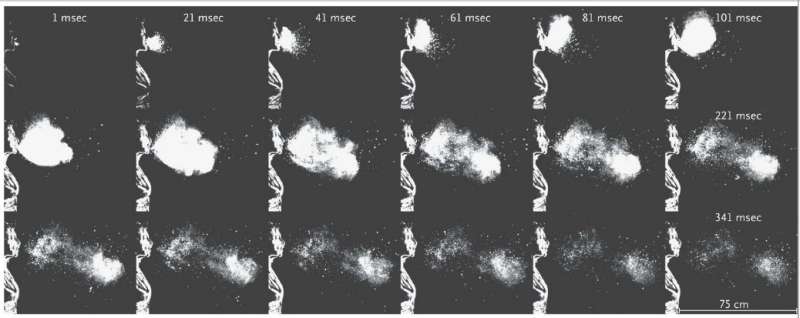August 29, 2016 report
Photographing sneezes at high speed may help find ways to reduce spread of disease

(Phys.org)—A team of researchers at MIT led by Lydia Bourouiba has discovered some new properties of sneeze clouds by photographing them with high speed cameras and then studying the footage. In their paper published in the New England Journal of Medicine, the researchers note that the physics of a sneeze cloud are more complicated than might be expected from such a simple event.
Humans sneeze because the body becomes aware of a foreign substance in the sinuses and reacts by forcefully expelling them. Unfortunately, bacteria and viruses can be expelled along with other material in cloud matter which can then be inhaled by other people in the area—causing them to become infected with a disease. In order to better understand what happens during a sneeze, Bourouiba and her team enlisted the assistance of several volunteers—each agreed to being photographed during the act of sneezing.
Viewing the results at normal and high speed revealed that there was more going on than expected. First, the researchers found that there were many kinds of movements, such as swirls and eddies. Second, they found that there was a wide range of droplet sizes—some relatively large and some very small. They also found that the cloud formed by a sneeze was very much impacted by the environment in which it occurred—air movement, humidity levels and temperature all had an impact on not only the size of the cloud, but its shape and duration. Most surprisingly of all, perhaps, was the finding that the tiniest droplets could remain suspended in the air for up to several minutes under the right conditions, and could travel as far as several feet. This meant, the researchers explain, that one person sneezing in a room could potentially infect every other person in that room.
The goal of the experiments, the researchers note, is to better understand what happens with sneeze clouds in places like hospitals so that changes can be made to reduce their size and duration. While research continues, they suggest that everyone sneeze into their elbows rather than directly into the air around them or into their hands. The objective should be to slow the droplets by causing them to collide with some object, such as a sleeve.

More information: Lydia Bourouiba. A Sneeze, New England Journal of Medicine (2016). DOI: 10.1056/NEJMicm1501197
Abstract
A human sneeze can eject droplets of fluid and potentially infectious organisms. The image sequence captures, in increments of 20 msec, the emission of a sneeze cloud produced by a healthy person. The sneeze was produced naturally, without the introduction of additives, colorants, or contaminants for visualization. High-speed video (Video 1, normal speed; Video 2, slowed down by a factor of 67), recorded at 1000 frames per second, shows a turbulent cloud that consists of hot and moist exhaled air, mucosalivary filaments and drops, and residues from droplet evaporation (nuclei). The ejection lasts up to 150 msec (top row) and then transitions into a freely evolving turbulent puff cloud (middle and bottom rows). The largest droplets rapidly settle within 1 to 2 m away from the person. The smaller and evaporating droplets are trapped in the turbulent puff cloud, remain suspended, and, over the course of seconds to a few minutes, can travel the dimensions of a room and land up to 6 to 8 m away.
Journal information: New England Journal of Medicine
© 2016 Phys.org



















